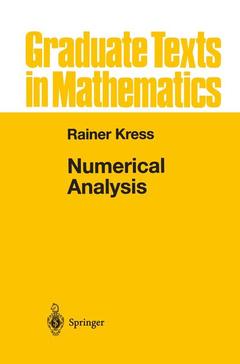Description
Numerical Analysis, Softcover reprint of the original 1st ed. 1998
Graduate Texts in Mathematics Series, Vol. 181
Author: Kress Rainer
Language: English
Publication date: 09-2012
326 p. · 15.5x23.5 cm · Paperback
326 p. · 15.5x23.5 cm · Paperback
Description
/li>Contents
/li>Comment
/li>
No applied mathematician can be properly trained without some basic un derstanding ofnumerical methods, Le., numerical analysis. And no scientist and engineer should be using a package program for numerical computa tions without understanding the program's purpose and its limitations. This book is an attempt to provide some of the required knowledge and understanding. It is written in a spirit that considers numerical analysis not merely as a tool for solving applied problems but also as a challenging and rewarding part of mathematics. The main goal is to provide insight into numerical analysis rather than merely to provide numerical recipes. The book evolved from the courses on numerical analysis I have taught since 1971 at the University ofGottingen and may be viewed as a successor of an earlier version jointly written with Bruno Brosowski [10] in 1974. It aims at presenting the basic ideas of numerical analysis in a style as concise as possible. Its volume is scaled to a one-yearcourse, i.e., a two-semester course, addressing second-yearstudents at a German university or advanced undergraduate or first-year graduate students at an American university.
1 Introduction.- 2 Linear Systems.- 2.1 Examples for Systems of Equations.- 2.2 Gaussian Elimination.- 2.3 LR Decomposition.- 2.4 QR Decomposition.- Problems.- 3 Basic Functional Analysis.- 3.1 Normed Spaces.- 3.2 Scalar Products.- 3.3 Bounded Linear Operators.- 3.4 Matrix Norms.- 3.5 Completeness.- 3.6 The Banach Fixed Point Theorem.- 3.7 Best Approximation.- Problems.- 4 Iterative Methods for Linear Systems.- 4.1 Jacobi and Gauss—Seidel Iterations.- 4.2 Relaxation Methods.- 4.3 Two-Grid Methods.- Problems.- 5 Ill-Conditioned Linear Systems.- 5.1 Condition Number.- 5.2 Singular Value Decomposition.- 5.3 Tikhonov Regularization.- Problems.- 6 Iterative Methods for Nonlinear Systems.- 6.1 Successive Approximations.- 6.2 Newton’s Method.- 6.3 Zeros of Polynomials.- 6.4 Least Squares Problems.- Problems.- 7 Matrix Eigenvalue Problems.- 7.1 Examples.- 7.2 Estimates for the Eigenvalues.- 7.3 The Jacobi Method.- 7.4 The QR Algorithm.- 7.5 Hessenberg Matrices.- Problems.- 8 Interpolation.- 8.1 Polynomial Interpolation.- 8.2 Trigonometric Interpolation.- 8.3 Spline Interpolation.- 8.4 Bézier Polynomials.- Problems.- 9 Numerical Integration.- 9.1 Interpolatory Quadratures.- 9.2 Convergence of Quadrature Formulae.- 9.3 Gaussian Quadrature Formulae.- 9.4 Quadrature of Periodic Functions.- 9.5 Romberg Integration.- 9.6 Improper Integrals.- Problems.- 10 Initial Value Problems.- 10.1 The Picard—Lindelöf Theorem.- 10.2 Euler’s Method.- 10.3 Single-Step Methods.- 10.4 Multistep Methods.- Problems.- 11 Boundary Value Problems.- 11.1 Shooting Methods.- 11.2 Finite Difference Methods.- 11.3 The Riesz and Lax-Milgram Theorems.- 11.4 Weak Solutions.- 11.5 The Finite Element Method.- Problems.- 12 Integral Equations.- 12.1 The Riesz Theory.- 12.2 Operator Approximations.- 12.3 Nyström’s Method.- 12.4 The Collocation Method.- 12.5 Stability.- Problems.- References.
Good introduction to an area experiencing rapid development for those in math, physics, and engineering. Gives a solid foundation by restricting the presentation to the basic principles and procedures, as well as the primary numerical algorithms. Includes the necessary functional analytic framework for a solid mathematical foundation in the subject. Gives particular emphasis to the question of stability. Presented in a concise and easily understandable fashion.
© 2024 LAVOISIER S.A.S.




